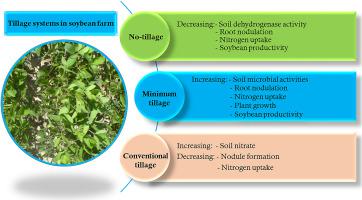Applied Soil Ecology ( IF 4.8 ) Pub Date : 2021-06-22 , DOI: 10.1016/j.apsoil.2021.104122 Salar Farhangi-Abriz , Kazem Ghassemi-Golezani , Shahram Torabian

|
Since tillage has an important role in changing soil properties and crop performance, a field experiment was conducted during two growing seasons (2018 and 2019) to assess the possible effects of three prevalent tillage systems (no-tillage, minimum and conventional tillage) on soil microbial activity, nodulation and yield of three soybean (Glycine max) cultivars (Williams 82, Zan and M7) under low content of soil organic matter (~1%). As a result, minimum and no-tillage improved soil basal respiration, metabolic quotient, acid phosphatase and β-glucosidase activities, while decreased soil pH, temperature and NO3-N concentration compared to conventional tillage. Under no-tillage, soil dehydrogenase activity, nodule formation, nitrogen uptake, growth, SPAD values and productivity of soybean cultivars were decreased, and also seedling establishment and day to maturity were delayed in comparison with conventional tillage. Nevertheless, soil microbial biomass carbon and organic matter content were not altered under no-tillage. In contrast, compared to other tillage practices, soil microbial biomass carbon, dehydrogenase activity and nodule formation were increased by minimum tillage resulted in an enhance in nitrogen uptake (~15%), growth, SPAD values, ground cover, grain, protein and oil yields of soybean (~6%). Averaged across tillage and year, the higher nodulation and nitrogen uptake were belonged to M7 and Zan cultivars, which resulted in more grain and protein yields. However, the highest oil yield was recorded in Williams 82. Overall, minimum tillage did not increase the soil organic matter content, but that improved soybean productivity by enhancing soil microbial activities, nodulation and nitrogen uptake; thus, it could be a suitable agronomical practice in the short-term to achieve acceptable yield.
中文翻译:

低有机质耕作制度下土壤微生物活性和大豆生产力的短期研究
由于耕作在改变土壤特性和作物性能方面起着重要作用,因此在两个生长季节(2018 年和 2019 年)进行了田间试验,以评估三种流行的耕作系统(免耕、最少耕作和常规耕作)对土壤的可能影响三种大豆(Glycine max)栽培品种(Williams 82、Zan 和 M7)在低土壤有机质含量(~1%)下的微生物活性、结瘤和产量。因此,最低限度和免耕提高了土壤基础呼吸、代谢商、酸性磷酸酶和 β-葡萄糖苷酶活性,同时降低了土壤 pH 值、温度和 NO 3-N 浓度与传统耕作相比。在免耕下,与常规耕作相比,大豆品种的土壤脱氢酶活性、根瘤形成、氮吸收、生长、SPAD值和生产力降低,并且幼苗建立和成熟日延迟。尽管如此,免耕下土壤微生物生物量碳和有机质含量没有改变。相比之下,与其他耕作方式相比,最少耕作增加了土壤微生物生物量碳、脱氢酶活性和根瘤形成,导致氮吸收(~15%)、生长、SPAD 值、地被植物、谷物、蛋白质和油的增加大豆产量(~6%)。平均跨耕和年份,较高的根瘤和氮吸收属于 M7 和 Zan 品种,这导致更多的谷物和蛋白质产量。然而,Williams 82 的油产量最高。总的来说,少耕没有增加土壤有机质含量,但通过增强土壤微生物活性、结瘤和氮吸收来提高大豆生产力;因此,在短期内实现可接受的产量可能是一种合适的农艺实践。











































 京公网安备 11010802027423号
京公网安备 11010802027423号